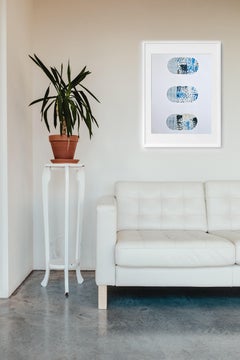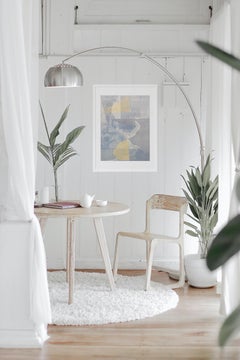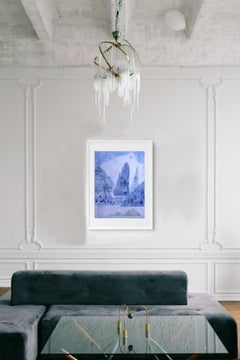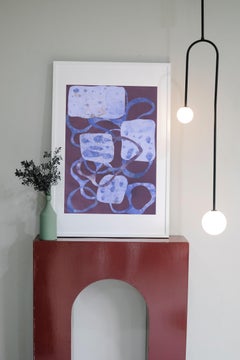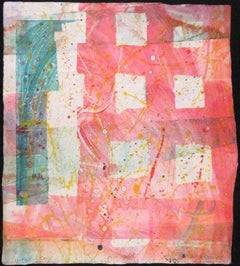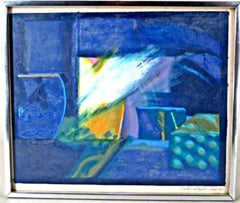Sarah Sczepanski Mixed Media
to
2
2
Overall Width
to
Overall Height
to
4
4
4
4
3
1
2
2
4
Daily Vitamins
Located in New York, NY
This is a monotype collage made from original monotypes that were then cut up into this abstract composition. I like using found objects and textures in my prints to create unique shapes and forms to be used in my collages.
Monotype collage on Rives BFK 280 gsm printmaking paper...
Category
2010s Abstract Mixed Media
Materials
Mixed Media, Monoprint, Monotype
Linear
Located in New York, NY
This original monotype was made from found textures and objects to make this unique landscape. This monotype is printed on Rives BFK 280 gsm Printmaking Paper...
Category
2010s Abstract Mixed Media
Materials
Monoprint, Monotype
Sea Stacks
Located in New York, NY
This original monotype was made from found textures and objects to make this unique landscape. This monotype is printed on Rives BFK 280 gsm Printmaking Paper...
Category
2010s Abstract Mixed Media
Materials
Monotype, Monoprint
Rusted Matter
Located in New York, NY
This original monotype was created using a series of found objects manipulated into these natural-like forms. This print is part of a series that can be purchased as a series or by t...
Category
2010s Abstract Mixed Media
Materials
Monotype
Related Items
Homage a Sam Francis, Folded Monoprint Mixed Media Splatter Painting Art Print
By Richard Royce
Located in Surfside, FL
This is a mixed media monoprint titled Homage a Sam (I first thought it was for Sam Gilliam but the artist told me it was for Sam Francis. He has done a number of these Homages as I have found a New York Times article referencing a "cast paper folded into an airplane shape by Richard Royce serves as an homage to the late sculptor Alexander Calder".Richard Royce, born New York, 1941.
After getting his BA and MA in fine art at the University of Wisconsin where he studied under Alfred Sessler...
Category
1980s Abstract Expressionist Mixed Media
Materials
Mixed Media, Handmade Paper, Monoprint
Milton Glaser signed abstract mixed media landscape mid century modern (unique)
By Milton Glaser
Located in New York, NY
MILTON GLASER
Untitled Abstract Landscape, 1965
Monotype with Mixed Media
11 × 13 inches
Signed and dated 1965 on the lower right recto
Unique
Frame included: held in original vinta...
Category
Mid-20th Century Abstract Abstract Prints
Materials
Mixed Media, Pencil, Graphite, Monotype, Screen
H 11.2 in W 13.25 in D 0.3 in
Large Abstract Modernist Monterey Series Mixed Media Monotype Colorful Painting
By Terence La Noue
Located in Surfside, FL
Terence La Noue was born in Hammond, Indiana in 1941. He received a Bachelor of Fine Arts from Ohio Wesleyan University in 1964. After going to Berlin as a Fulbright Meister Student ...
Category
1980s Abstract Expressionist Abstract Paintings
Materials
Paint, Mixed Media, Monotype
Conceptual Pop Art Color Oil Monotype Painting Abstract Figure Robin Winters
By Robin Winters
Located in Surfside, FL
Robin Winters (American, born 1950),
Untitled (Red Face) from "Cherry Block Series" 1986, monotype, pencil signed and dated lower right, plate: 6"h x 8.5"w, overall (with frame): 22.25"h x 18.25"w. Provenance: Property from a Private Collection, San Francisco.
Winters was invited to make monotypes at Experimental Workshop in San Francisco, (they printed Richard Bosman, Sam Francis, Claire Falkenstein, Deborah Oropallo and Kenneth Noland and many more greats). Winters chose to paint on wood blocks rather than the more usual metal plates in order to capture the organic quality of the natural material. He exploited a salient characteristic of the monoprint in Ghost Story by adding new painted elements onto the increasingly faint ghost images that result from successive impressions from a single block. In so doing he achieved the effect of transparent layers of color and shadow imagery. Winters's brightly-colored monotypes portray an array of figures and landscapes (and an occasional still-life) that, although can be seen in the context of a general trend away from abstraction that has marked the 1980s, defy strict stylistic categorization. They are neither realistic nor abstract, psychological self-examinations nor narrative fictions, but they contain elements of all of these approaches. Like Jonathan Borofsky, Winters derives much of his subject matter from dreams, believing that through his private fears and obsessions he can touch similar emotions in others. Although at first glance Winters's images look as if they could have been made by a child, closer attention reveals sly art historical references to Jackson Pollock and Pattern Painting (the drip and splatter backgrounds), Mark Rothko (the three-part horizontal compositions) and Minimalism (the gridded Cherry Block Series: Bread Beat).
Robin Winters (born 1950 in Benicia, California) is an American conceptual, multi-disciplinary, artist and teacher based in New York. Winters is known for creating solo exhibitions containing an interactive durational performance component to his installations, sometimes lasting up to two months. Winters first emerged in the burgeoning Soho NYC art scene of the 1970s. An early practitioner of the Relational Aesthetics (social interaction as an art medium) Winters also created in works through sculpture, installation, performance, painting, drawing and prints. His art maintains a whimsical spirit, and he often returns to ongoing themes involving faces, boats, cars, bottles, hats and jesters or fools. Winters has incorporated such devices as blind dates, double dates, dinners, fortune telling, and free consultation in his performances. Throughout his career he has engaged in a wide variety of media, such as performance art, film, video, writing prose and poetry, photography, installation art, printmaking, drawing, painting, ceramic sculpture, bronze sculpture, and glassblowing.
Winters was born in Benicia, California in 1950 to lawyer parents. As a child his hobby was collecting glass bottles found on the beach and under old buildings, which would later influence him as an artist. In 1968, Winters had his first durational performance, entitled Norman Thomas Travelling Museum. The artist drove a Volkswagen bus decorated in collage, many of the images relating to current events and politics. Inside was what the artist described as a “reliquary” containing many objects, including a bottle collection. Winters took the van to shopping centers and even as far as Mexico. That same year, Winters opted not to register for the military draft. Although he was deemed fit to serve, Winters refused. In 1975 the resulting legal proceedings finally came to a close after it was proven that the artist had been harassed by the local draft board. In his teens and early twenties, Winters became acquainted with several local artists who helped shape his aesthetic, most notably Manuel Neri and Robert Arneson. By the early 1970s, Winters was studying at the San Francisco Art Institute (SFAI) and had relocated to San Francisco. At this time Winters became friends with the Bay Area conceptual artists Terry Fox and Howard Fried, and participated in several of Fried's performance works. In 1972 Winters was accepted into the Whitney Independent Study Program in New York City. After coming to New York City, Winters helped support himself by working for various artists, among them the performance artist Joan Jonas and sculptor Donald Judd. In 1974, Winters performed The Secret Life of Bob-E or Bob-E Behind the Veil eight hours a day, five days a week for a month in his studio apartment. Behind a one-way mirror the audience could watch Winters play the character of Bob-E, whose goal was to make a monument for everyone in the world in the form of blue and yellow rubber top hats. By the end of the month the artist had constructed 262 hats. The following year, Winters was invited to take part in the Whitney Museum's 1975 Biennial Exhibition. Entitled W.B. Bearman Bags a Job or Diary of a Dreamer. Winters was traveling in 1975 and 1976, spending time in North Africa and in Europe. At a time when most young American artists were unaware of their European counterparts, Winters met and was influenced by such artists as Sigmar Polke and Marcel Broodthaers (with whom Winters worked on an installation) and also had a one-person exhibition, at the Konrad Fischer Gallery in Dusseldorf. Returning to New York in 1976, Winters teamed up with a group of artists to form Collaborative Projects (Colab), a rather anarchistic organization dedicated to artistic collaboration and the creation of art that questioned social values.. Also in 1976, Winters formed the partnership “X&Y” with fellow artist Coleen Fitzgibbon that would last two years. Together they performed a series of shows in the Netherlands, most notably a show entitled Take the Money and Run. Performed at De Appel in Amsterdam, the show involved the artists robbing their audience. The following day the audience was given an apology, as well as the opportunity to retrieve any valuables and participate in a lottery to win the artists’ services. They also made a Super 8 film in NY called Rich-Poor, in which they asked people on the streets their thoughts on the rich and poor.
In 1980 Winters participated in The Real Estate Show and in Absurdities at ABC No Rio. That same year he and artists Peter Fend, Coleen Fitzgibbon, Peter Nadin, Jenny Holzer, and Richard Prince also formed The Offices of Fend, Fitzgibbon, Holzer, Nadin, Prince & Winters. This short-lived collective was based out of an office on lower Broadway and offered “Practical Esthetic Services Adaptable to Client Situation”, as stated on their business card. Their goal was to offer their art as “socially helpful work for hire”. In June of that year Winters participated in The Times Square Show, Colab's most well-known exhibition. The month-long show took place in a four floor building on West 41st Street and was densely packed with art. To cap off a busy year, Winters also became one of the first artists to join the Mary Boone Gallery, showing a successful solo exhibition in 1981. His work was shown in the New York/New Wave show in 1981 at MoMA PS1 along with Jean-Michel Basquiat, Roberta Bayley, William S. Burroughs, David Byrne, Sarah Charlesworth, Larry Clark, Crash (John Matos), Ronnie Cutrone, Brian Eno, Peter Fend, Nan Goldin, Keith Haring, Ray Johnson, Joseph Kosuth, Marcus Leatherdale, Christopher Makos, Robert Mapplethorpe, Elaine Mayes, Frank Moore, Kenny Scharf and others. In 1982, Winters had his first solo exhibition in Los Angeles at the Richard Kuhlenschmidt Gallery. At the Mo David Gallery in 1984, Winters created an installation piece that consisted of a floor of plaster tiles. Underneath each tile, hidden from view, was a drawing. He designed the stage sets for the musician Nico, and assisted French artist Orlan, American artist Stuart Sherman, and American poet Gregory Corso. Two years later Winters was invited to take part in Chambres d’Amis (In Ghent there is Always a Free Room for Albrecht Durer) in Ghent, Belgium. In it, 51 artists created installations in 50 different sites, mostly private homes. Winters chose the home of a local art historian. The artist made 90 drawings based on images found in the large collection of art books in the home's library. He made two copies of each drawing and placed the originals in the books themselves. One set of copies was exhibited in the sponsoring museum, Museum van Hedendaagse, as "The Ghent Drawings". The drawings were also on display at Winters’ solo exhibition at Luhring Augustine & Hodes Gallery in New York City in 1987.
In 1986, Winters had a solo exhibition at Maurice Keitelman Gallery in Brussels, Belgium, and the following year a solo exhibition at the Centre Régional d'Art Contemporain Midi-Pyrénées in Toulouse, France. Also in 1986, Winters' Playroom was held at the Institute for Contemporary Art in Boston, Massachusetts. The exhibition was part of Think Tank, a retrospective of Winters' work which traveled to the Stedelijk Museum in the Netherlands, the Centre Regional d’Art Contemporain in France, and the Contemporary Arts Center in Ohio. Winters spent a month in 1989 working with students at the San Francisco Art Institute. Never having worked with ceramics, he spent the month making numerous ceramic pieces, which were then shown in the aptly named One Month in San Francisco. Other components of the piece included Winters’ childhood bottle collection and a video showing each piece in the show filmed briefly next to a ruler.[ Also that year, Robin served as a visiting artist at the Pilchuck Glass School, where he met artist John Drury, who was then working as the school's artist liaison.
In the summer of 1990, Winters interviewed fellow artist Kiki Smith for her eponymous book, which was published later that year. That same year (1990), Winters was invited by the Val Saint Lambert glass factory in Belgium to create glassworks in their facility. Winters, artists John Drury and Tracy Glover...
Category
1980s Pop Art Figurative Paintings
Materials
Monoprint, Monotype
Amid The Blue Waves
Located in Clayton, MO
In Amid The Blue Waves color, line, shape, and texture collide with handwritten romantic fragments of prose on Kozuke ivory paper. This one-of-a-kind, unmounted encaustic monotype il...
Category
2010s Abstract Abstract Paintings
Materials
Wax Crayon, Sumi Ink, India Ink, Encaustic, Archival Paper, Rice Paper, ...
Origin 8"-5, by Seiko Tachibana
By Seiko Tachibana
Located in Palm Springs, CA
A unique monotype with charcoal, graphite and acrylic makes the textures as important as the image.
Seiko Tachibana was born in Japan and completed her Masters of Art Education at K...
Category
Early 2000s Abstract Mixed Media
Materials
Charcoal, Mixed Media, Acrylic, Graphite, Monotype
"365 Vessels", Mixed technique on tissue white paper, Minimalist, 50 x 33 cm
Located in Carballo, ES
This series of works by the Danish artist Peter Kramer (Roskilde, 1959) with numerous exhibitions between Spain and Denmark are entitled "365 urns", in wh...
Category
21st Century and Contemporary Abstract Expressionist Mixed Media
Materials
Organic Material, Adhesive, Ink, Mixed Media, Acrylic, Handmade Paper, T...
H 19.69 in W 13 in D 0.08 in
Large 3D Cast Paper Abstract Oil Monoprint Unique Monotype Painting John Walker
By John Walker
Located in Surfside, FL
John Walker British (b. 1939)
Salsipuedes Forms (1991)
Monoprint relief print with dry pigment, monotype
Hand signed lower right
Provenance: Garner Tullis Workshop
A monotype is literally one of a kind; it is not a method of multiplication. The artist makes an image with a liquid medium on wood, metal or glass, and paper is laid over the moist image and bonded under pressure the paper is then removed bringing with it the transposed monotype.
John Walker (born 1939) is an English painter and printmaker. He has been called "one of the standout abstract painters of the last 50 years." Walker studied in Birmingham at the Moseley School of Art, and later the Birmingham School of Art and Académie de la Grande Chaumière in Paris. Some of his early work was inspired by abstract expressionist art and post-painterly abstraction, and often combined apparently three-dimensional, sculptural shapes with "flatter" elements. These pieces are usually rendered in acrylic paint.
In the early 1970s, Walker made a series of large...
Category
1990s Abstract Expressionist Mixed Media
Materials
Monoprint, Monotype
Large 3D Cast Paper Abstract Oil Monoprint Unique Monotype Painting John Walker
By John Walker
Located in Surfside, FL
John Walker British (b. 1939)
Salsipuedes Forms (1991)
Monoprint relief print with dry pigment, monotype
Hand signed lower right
Provenance: Garner Tullis Workshop
A monotype is literally one of a kind; it is not a method of multiplication. The artist makes an image with a liquid medium on wood, metal or glass, and paper is laid over the moist image and bonded under pressure the paper is then removed bringing with it the transposed monotype.
John Walker (born 1939) is an English painter and printmaker. He has been called "one of the standout abstract painters of the last 50 years." Walker studied in Birmingham at the Moseley School of Art, and later the Birmingham School of Art and Académie de la Grande Chaumière in Paris. Some of his early work was inspired by abstract expressionist art and post-painterly abstraction, and often combined apparently three-dimensional, sculptural shapes with "flatter" elements. These pieces are usually rendered in acrylic paint.
In the early 1970s, Walker made a series of large...
Category
1990s Abstract Expressionist Mixed Media
Materials
Monoprint, Monotype
Untitled (Islands)
By Friedel Dzubas
Located in Toronto, Ontario
Friedel Dzubas (1915-1994) was a Berlin-born American abstract painter. He was associated with both the New York School and the Color Field movement.
Dzubas studied art in Germany ...
Category
1980s Abstract Geometric Mixed Media
Materials
Handmade Paper, Monoprint, Monotype
Criss Cross, Red Abstract Design Work on Paper
By a.muse
Located in New york, NY
In the artist's Art on Design original print series Criss-Cross, 2019 by a.muse is a work on missed connections and chance meetings. A geometric work on paper, 11.5" x 9.5" Criss-Cr...
Category
2010s Abstract More Art
Materials
Rag Paper, Monotype, Handmade Paper, Ink
Untitled
Located in Llanbrynmair, GB
’Pisces’
Please note. This is not a mono print but 1st Dibs have option for Relief print. Which is what this is...
By Yutaka Takayanagi.
Medium - Relief print
Edition - AP
Signed - Yes
Size - 510mm x 660mm
Date - 1973
Condition - Excellent. 10 out of 10.
Born in Tokyo in 1941, Takayanagi's artistic journey began when he enrolled at Tokyo University of the Arts in 1960, studying under the renowned oil painter Kaoru Yamaguchi. His talent was quickly recognized when he received an Honorable Mention at the 8th Shell Arts Award Exhibition in the same year.
During his time at university, Takayanagi took an intensive course in copper plate printing under Tetsuro Komai, receiving his degree from the graduate school in 1966. Fascinated by the simultaneous color print method, he started creating copperplate prints and soon gained recognition for his unique metallic reliefs, which he produced using collages of English newspapers.
Takayanagi's passion for experimentation led him to create metallic emboss reliefs using his own photographs, and in the latter half of the 1980s, he moved on to silkscreen prints. He continued to push the boundaries of his art, constantly exploring new techniques and mediums.
In 1978 and the following year, Takayanagi was appointed as an arts researcher for the Ministry of Culture and traveled to the United States, France, and the UK. These experiences enriched his artistic perspective and further cemented his reputation as a highly regarded artist.
Takayanagi was part of the influential printmaking group Sosaku Hanga, which emerged in the early 20th century in Japan. This movement emphasized the artist's involvement in every stage of the printmaking process, from designing the image to carving and printing the blocks.
Takayanagi's work often incorporates elements of nature and landscape, with an emphasis on texture and pattern. He also experimented with collage, incorporating found materials like newspaper clippings and photographs into his prints.
Takayanagi's work has been exhibited extensively in Japan and internationally, including at the Museum of Modern Art in New York and the National Museum of Modern Art in Tokyo. He has also received numerous awards for his contributions to printmaking, including the Japan Print Association Award and the Purple Ribbon Medal...
Category
1970s Abstract Abstract Prints
Materials
Monoprint
